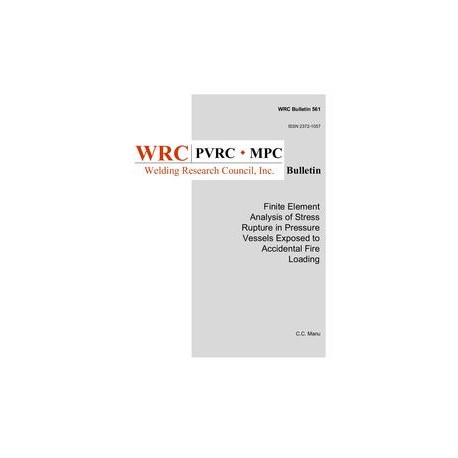Cart
0
Product
Products
(empty)
No products
To be determined
Shipping
$0.00
Total
Product successfully added to your shopping cart
Quantity
Total
There are 0 items in your cart.
There is 1 item in your cart.
Total products
Total shipping
To be determined
Total
 View larger
View larger
WRC 561
M00002276
New product
WRC 561 Finite Element Analysis of Stress Rupture in Pressure Vessels Exposed to Accidental Fire Loading
Bulletin / Circular by Welding Research Council, 2015
C.C. Manu
In stock
More info
Full Description
A numerical model that predicts high temperature pressure vessel rupture was developed. The finite element method of analysis was used to determine the effects that various parameters had on pressure vessel failure. The work was concerned with 500, 1000 and 33000 US gallon pressure vessels made of SA 455 steel. Experimental pressure vessel fire tests have shown that vessel rupture in a fully engulfing fire can occur in less than 30 minutes. This experimental work was used both to validate the numerical results as well as to provide important vessel temperature distribution information.Due to the fact that SA 455 steel is not meant for high temperature applications, there was little published high temperature material data. Therefore, elevated temperature tensile tests and creep rupture tests were performed to measure needed material properties. Creep and creep damage constants were calculated from SA 455 steel?s creep rupture data.
The Kachanov One-State Variable technique and the MPC Omega method were the creep damage techniques chosen to predict SA 455 steel's high temperature time-dependent behaviour. The specimens used in the mechanical testing were modeled to numerically predict the creep rupture behaviour measured in the lab. An extensive comparison between the experimental and numerical uniaxial creep rupture results revealed that both techniques could adequately predict failure times at all tested conditions; however, the MPC Omega method was generally more accurate at predicting creep failure strains. The comparison also showed that the MPC Omega method was more numerically stable than the One-State Variable technique when analyzing SA 455 steel's creep rupture.
The creep models were modified to account for multiaxial states of stress and were used to analyze the high temperature failure of pressure vessels. The various parameters considered included pressure vessel dimensions, fire type (fully engulfing or local impingement), peak wall temperature and internal pressure. The objective of these analyses was to gain a better understanding of the structural failure of pressure vessels exposed to various accidental fire conditions.
The numerical results of rupture time and geometry of failure region were shown to agree with experimental fire tests. From the fully engulfing fire numerical analyses, it was shown that pressure vessels with a smaller length to diameter ratio and a larger thickness to diameter ratio were inherently safer. It was also shown that as the heated area was reduced, the failure time increased for the same internal pressure and peak wall temperature. Therefore, fully engulfing fires produced more structurally unstable conditions in pressure vessels then local fire impingements.

